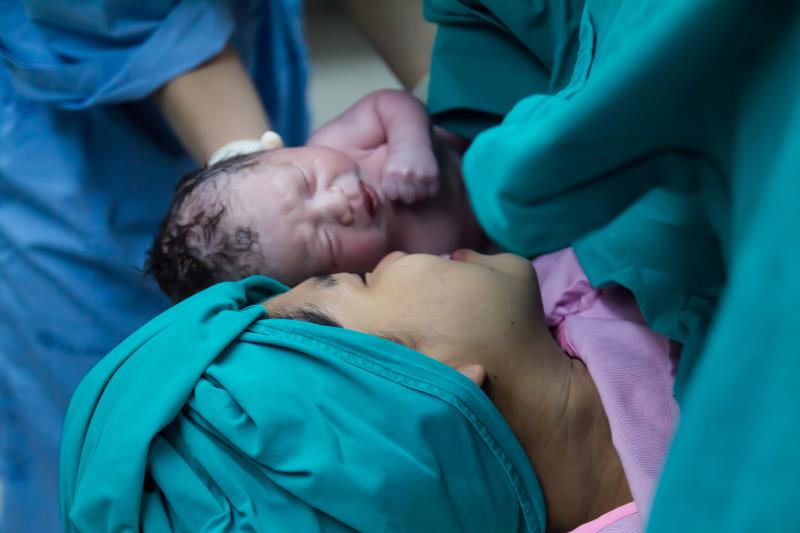
The administration of adjunctive azithromycin prior to unscheduled Caesarean sections may reduce post-surgical infection risk, according to a study presented at SMFM 2020.
The study investigators observed infection rates (a composite of endometritis, surgical site infection [SSI], and other major infections) occurring within 30 days of non-scheduled Caesarean sections. The infection rates were compared as 1-year prior (n=515) and 1-year after (n=805) implementation of the adjunctive azithromycin protocol.
After adjusting for BMI, race, diabetes status, tobacco use, presence of labour, rupture of membranes, and type of skin closure, the implementation of an adjunctive azithromycin protocol led to a reduction in 30-day infection rates following non-scheduled Caesarean delivery (4.5 percent vs 9.3 percent; adjusted odds ratio [adjOR], 0.46, 95 percent confidence interval [CI], 0.29–0.74). [SMFM 2020, abstract 316]
Assessment of individual components of the composite* showed a reduction in the 30-day rates of endometritis (2.4 percent vs 5.1 percent; adjOR, 0.47, 95 percent CI, 0.25–0.87) and wound infections** (2.0 percent vs 3.9 percent; adjOR, 0.52, 95 percent CI, 0.25–1.06).
Maternal sepsis, pneumonia, pyelonephritis, and abdominal or pelvic abscess (grouped as “other infections”) occurred at a low rate (six and three incidents in the pre- and post-assessment periods, respectively).
“Successful implementation of an adjunctive azithromycin protocol decreased composite infections following non-scheduled Caesarean delivery. This demonstrates real-world efficacy of azithromycin prophylaxis with similar risk reduction to that seen in randomized controlled trials [RCTs],” noted the investigators.
In a separate single-centre, retrospective study, researchers in Israel found that timing of antimicrobial prophylaxis prior to Caesarean section did not affect SSI incidence.
Researchers from the Emek Medical Center in Afula, Israel, looked at data of 2,989 women who had delivered via Caesarean section. Of these, 2,791 had received antimicrobial prophylaxis within 30 minutes prior to skin incision (group 1; mean time from prophylaxis to incision, 14.37 minutes) and 198 had received prophylaxis within 30–60 minutes pre-incision (group 2; mean time from prophylaxis to incision, 43.41 minutes).
The incidence of SSI was more than halved in group 2 compared with group 1 (0.51 percent vs 1.08 percent); however, this finding was not statistically significant (p=0.71). [SMFM 2020, abstract 879]
“Incidence of SSI was comparable between women who received antimicrobial prophylaxis within 30 compared to 30–60 minutes before skin incision,” said the researchers.
Prophylactic CHG ineffective in scheduled C-secs
In terms of scheduled Caesarean sections, pre-surgery application of chlorhexidine gluconate (CHG) did not reduce the risk of post-surgical SSI, as demonstrated in the STRIPES*** study.
The researchers of this single-centre trial randomized women who were scheduled for a Caesarean section to apply either 2% CHG cloths (n=672) or comfort bath cloths (placebo group; n=674) to six sites on the body# twice a day (night prior and after a shower on the morning of scheduled Caesarean section).
Six weeks post-surgery, the incidence of superficial or deep SSI did not differ between women who received CHG and placebo (2.6 percent vs 3.7 percent; p=0.24). [SMFM 2020, abstract LB2]
There was also no difference between CHG and placebo at the 2-week mark, be it for SSI (2.4 percent vs 3.5 percent; p=0.23) or other wound-related complications (eg, fever: 0.4 percent vs 0.3 percent; p>0.99; drainage: 2.5 percent vs 2.3 percent; p=0.76; endometritis: 0 vs 0.2 percent; p=0.50).
“This is the first RCT to evaluate pre-operative use of CHG for scheduled Caesarean sections. This study may help in the development of SSI reduction guidelines in this population,” said the researchers.